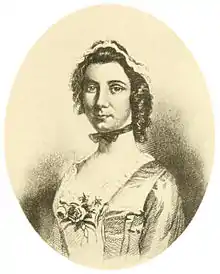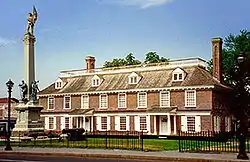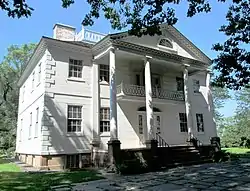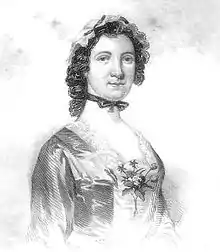Mary Philipse
Mary "Polly" Philipse (1730–1825) was the middle daughter of Frederick Philipse II, 2nd Lord of Philipsburg Manor of Westchester County, New York. Of Anglo-Dutch extraction, she was a wealthy heiress, possible early love interest of George Washington, and New York City socialite. Married to an ex-British army colonel, her Loyalist sympathies in the American Revolution reshaped her life.

At the age of 22 she inherited one-third of her father's roughly 250 sq mi (650 km2) "Highland Patent", which sprawled from the Hudson Highlands on the west bank of the lower Hudson River to the Connecticut Colony in the east.
In 1758 she married in New York Englishman Roger Morris (January 1727 – September 1794), who had fought extensively in the French and Indian War.[1]
With Roger's appointment to the Governor’s Council of the Province of New York the couple became pillars of the local establishment. A year after their marriage Morris had a large country estate, Mount Morris, built in northern Manhattan between the Hudson and Harlem rivers in what is now Washington Heights.[2]
The family lived there until 1775. Roger fled to England at the onset of the Revolution, returning two years later. In 1779 the government of the Colony of New York seized both Morris' personal property and Mary's inheritances. Despite assurance of restitution in the 1783 Treaty of Paris [3] no compensation was forthcoming. The family relocated to England.
It was later found that a provision in the couple's prenuptial agreement creating a life trust transferable to their children had protected her Highland Patent inheritance from the 1779 bill of attainder. In 1809 the Morris heirs finally received from John Jacob Astor £20,000 sterling for their rights to the disputed lands.
Mary died in York, England at the age of 96. A monument is erected over her grave at St Saviour’s Church there.[4]
Highland inheritance
.png.webp)
Mary was, along with her elder brother Philip, older sister Susanna (1727–1822), and younger sister Margaret (1733-1752), a one-quarter heir to the roughly 250 sq mi (650 km2) "Highland Patent" of her father (later to become known as the Philipse Patent, and in time today's Putnam County of southeastern New York).
Margaret Philipse died intestate, and her share of the Patent was equally divided among her named living siblings. A redistribution of the land among them was done in 1754.[5]
The Washington legend

George Washington was a Colonel in service to the British Army during the French and Indian War, serving from 1753 to 1758.
He was acquainted with Joseph Chew (b. 1725), a Colonial merchant and port surveyor in New London, Connecticut, through Chew's brother Colby, who served in Washington's Virginia Regiment. Chew was a friend of the Robinson and Philipse families. In early 1756 Washington had shared company with then retired Captain Beverley Robinson and his wife Susanna, Mary's elder sister. Mary, known as "Polly", had caught Washington's eye. In 1756-1757 Chew wrote several letters to him, which survive and begat the legend of a doomed Washington/Mary Philipse love. Washington's letters to Chew – or Polly – have never surfaced.
Chew often stayed at the Philipse Manor house, the family seat on the Hudson in today's Yonkers, during his trips to Boston, and visited with Mary at the Robinson home on the Hudson in the Philipse Patent. Among his letters were the following passages:
- 4 March 1756: "I have this moment a Letter from our Worthy friend B. Robinson, he, Mrs. Robinson, the agreeable Miss Polly and all his family are Very well."
- 14 March 1757: "I am now at Mr. Robinson’s, he, Mrs. Robinson and his Dear Little Family are all well and they desire their Compliments to you. Pretty Miss Polly is in the same Condition & situation as you saw her." ("Condition & situation" have been interpreted as references to Mary’s alleged affections for Washington, although such language was also employed with regards to a person's health and overall spirits.)
- 13 July 1757: "As to the Latter part of your Letter what shall I say? I often had the Pleasure of Breakfasting with the Charming Polly. Roger Morris was there (don’t be startled) but not always; you know he is a Lady’s man... " (Morris ultimately married Mary Philipse in January 1758.)
- 13 July 1757: "I intend to set out tomorrow for New York where I will not be wanting to let Miss Polly know the sincere Regard a Friend of mine has for her and I am sure if she had my Eyes to see thro she would Prefer him to all others." (The "Friend" being George Washington.)
According to Washington biographer Douglas Southall Freeman, a match between George and Polly had been considered a possibility.[6][7]
Within a year of his mention Mary and Roger Morris were married.
American Revolution

Morris and his family lived in Mount Morris from 1765 until 1775, when the American Revolution began. A Loyalist, Morris went to England at the start of the war, while his wife and family stayed at the family Manor house in Yonkers.[8] Between 14 September – 20 October 1776, General George Washington used the Morris mansion as his temporary headquarters. There is no record of any communication during the war between Washington and Polly.
Morris returned to New York in 1777, after the city had been captured by the British. In 1779, estates of 58 prominent Loyalists, including the Morris home and Mary's share of the Philipse Patent, were confiscated by the Commissioners of Forfeiture of the New York Colony. Despite assurance of restitution in the 1783 Treaty of Paris [9] compensation was not forthcoming.
After the war

Before wedding, Philipse and Morris had signed a prenuptial agreement that shared a life lease of the estate between husband and wife, transferred to their children after their death.[10] After the war it was subsequently shown in court that as a result the Morris share of the Philipse Patent was vested in their children and had not been reached by New York's bill of attainder.[11] Unfortunately, a resolution ground along for decades before progress was made.
In 1809 America's first robber baron, John Jacob Astor, bought the interest of the Morris heirs, which included Polly, for this property for £20,000 sterling, then brought suit against the State to recover the lands – or at least the rents due upon them – from the former tenant farmers who had been able to acquire their holdings from the Colonial government of New York for a fraction of their value during the dark days of the Revolution when the Continental Army was desperate for funds.[12]
Astor's gambit failed, but the Morris family was able to retain his payment. It was not until 1832 that Astor was paid some $561,000 by the state of New York to drop his claims.[12]
Family
The Morrises had two sons and two daughters. Sons Amherst and Henry Gage both served in the Royal Navy, as a lieutenant and rear-admiral, respectively.[13]
References
- Simmons, Richard C. (1965). "Mrs. Morris and the Philipse Family, American Loyalists". Winterthur Portfolio. 2: 14–26. doi:10.1086/495749. JSTOR 1180449. S2CID 162240184.
- "A Brief History of the Morris-Jumel Mansion". Morris-Jumel Mansion. Retrieved April 18, 2018.
- Description of the Abstract of Sales, Commissioners of Forfeiture
- Women of the American Revolution: Mary Philipse
- French's Gazetteer of the State of New York (1860): “The Philipses Patent… divided among the remaining three [children] Philip… Susannah married to Beverly Robinson, and Mary married to Col. Roger Morris. On the 7th of Feb 1754, the patent was divided into 9 lots: 3, each 4 mi. square, bordering upon the Hudson and denominated ‘water lots;’ 3, each 4 mi. wide by 12 long, extending N. and S. across the patent, and denominated ‘long lots;’ 3, each 4 mi. square, upon the E. border denominated ‘back lots.’ Philip, Susannah and Mary Philipse each owned one of each kind of lots."
- Freeman, Douglas Southall. George Washington, Volume 2: Young Washington (1948) p. 160)
- Philipse Manor Hall State Historic Site and Museum website.
- Morris-Jumel Mansion Interior Designation Report Archived 2016-03-03 at the Wayback Machine, New York City Landmarks Preservation Commission, 27 May 1975.
- Description of the Abstract of Sales, Commissioners of Forfeiture
- Ward, Harry M. (January 1999). "Morris, Roger". American National Biography. Retrieved April 18, 2018 – via Oxford University Press.
- Philipse Manor Hall State Historic Site and Museum website
- French's Gazetteer of the State of New York (1860)
- Chichester, Henry Manners (1894). . In Lee, Sidney (ed.). Dictionary of National Biography. 39. London: Smith, Elder & Co. pp. 105–106.